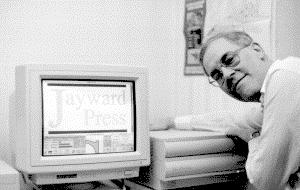RISC OS Computers: the RISC OS Operating System


The Operating System Acorn wrote for their ARM-processor powered computers is called RISC OS, and in its first version appeared in early 1989 after having been shown to the public at the PCW Show in September 1988.
This Operating System was blown into read-only chips (ROMs) so could not be corrupted or deleted. It fitted into a just half a Megabyte of ROM chips, yet exhibited advanced multi-tasking capabilities, a superb desktop user interface and had a somewhat UNIX-like script programming language built in. Although it was nowhere near perfect it was certainly an impressive achievement.
Though its three-button mouse took time to learn to handle to full benefit, users soon grew accustomed to working in the amazingly productive way that RISC OSmade possible; and even now, some twelve years later, there are still many thousands of dedicated users. Many of these users have other systems available to them (typically at their places of work) but a healthy proportion prefer RISC OS and simply find it more productive, more convenient in use and less frustrating than other systems.
Such innovations as the iconbar at the foot of the screen, button bar (first seen in ArcWriter back in January 1988!), accurate and smooth text display (anti-aliasing, still performed best on RISC OS), multiple views of the same document, drag-and-drop data and file handling, among many others were pioneered on this platform, many back in the days when other systems were essentially still single-tasking. It is no wonder that they became the platform of choice for education, as the rest of the world would have caught up with the way our youngsters had learned to work by the time they went out to get a job. That situation has now changed, but only after many years of Acorn/RISC OS dominance of the education market.
Here is a screenshot (at half scale: the original was 1600 ×1200 pixels!) of an issue of a newsletter I produced for my former employer back in 1994. Not only does this show the iconbar—rather full of icons at the time, I notice—and the multiple views of the same file, but also the very clear (and accurate) text display.

This has for years enabled me to produce some very high quality work accurately, as I always knew precisely how the finished product would appear once printed, as in this roundel I produced for an annual competition: the final version was printed at almost a metre in diameter, so it had to be spot on.

It has also been helpful to have such wonderful tools available as Draw, a surprisingly advanced object-based vector drawing package that is built into all versions of RISC OS. As it is in the ROM chips of the Operating System it takes very little memory to run, too—just 76 Kbytes for just the program itself on my system.
Here is the design I created from a sketch (also shown here) for a dog grooming service.

So, we can readily see from these few examples that RISC OS is not just a powerful and conceptually advanced Operating System, it is also an excellent platform on which to work to produce real results, with a lot of genuinely useful and productive tools to perform all manner of tasks: textual, graphical, mathematical, video (an open-ended capability thanks to the innovative Acorn Replay), sound, on-line communications among many others. I know I'd feel lost without my trusty RISC OS computers, and I am far from being alone in that.
![]() The current version of the Operating System is RISC OS 4.
The current version of the Operating System is RISC OS 4.

The RISC OS Web Ring This RISC OS WebRing site is owned by John M Ward [Skip Prev]
[Prev]
[Random]
[Next]
[Skip Next]
[Next 5]RISC OS enthusiasts unite! Join the RISC OS WebRing